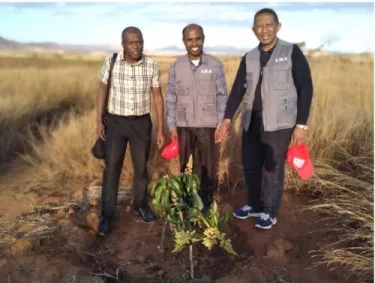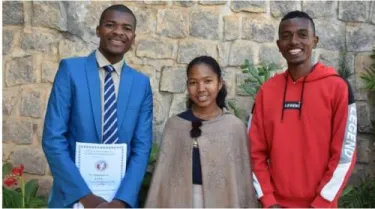Madagascar, Climate Change and Hope
A Letter from Dan and Elizabeth Turk, serving in Madagascar
Subscribe to our co-worker letters
Dear friends,
The United Nations considers Madagascar to be one of the countries most vulnerable to climate change. Along with warmer temperatures, climate change is expected to cause cyclones that are more numerous and more intense as well as extensive droughts leading to increased hunger and deforestation.
In Madagascar, when people have a hard time getting enough to eat, they often turn to the forest to get income to buy food, cutting native trees to make charcoal and doing slash-and-burn agriculture to grow corn and other crops.
Madagascar’s native forests are characterized by very high numbers of endemic species (species found naturally only in Madagascar). The Red List of Trees of Madagascar cataloged 3,118 native tree species in Madagascar, of which 93% are endemic. The forests are also fast disappearing. It has been estimated that since 1950, half of Madagascar’s native forests have been destroyed.

The native forests are the habitat for the vast majority of Madagascar’s endemic plants and animals including tenrecs and lemurs. When the native forest gets cut down, it seldom if ever regains the level of biodiversity found in the original forest. In many cases, once the trees are cut to grow crops or to make charcoal, the native forest does not return. Instead over the course of years, the forest becomes reduced to grassland. In many parts of the country, native trees are being replaced with trees of fast-growing introduced species, like Eucalyptus spp., Pinus spp., and acacias from Australia. While fast-growing introduced species are needed to provide wood for cooking meals and building houses, it is sad that native trees are disappearing from Madagascar’s landscapes.
The destruction of native forests is not due to climate change alone but to a myriad of intertwining reasons that have a lot to do with the growing population, poverty, high demand for forest products, and inherently infertile soils.
We have personally seen forests disappear during our time as mission co-workers in Madagascar. The forest of Ialatsara near Ambohimahasoa in south-central Madagascar is now essentially gone, with all the large trees having been cut down for wood and charcoal. About a year ago, I still saw brown lemurs there, but don’t expect to see them again.
Southern Madagascar is especially vulnerable to hunger and loss of biodiversity. In the far south, rainfall in good years is very low. El Niño can cause drought that can last years as happened in 2016-2021, sending tens of thousands of people to the brink of starvation. In times of drought, many people in the far south eat only cactus fruits for months on end.
This year El Niño is again causing extreme weather patterns in many parts of the world. Currently, most of Madagascar is in the middle of its annual dry season. The hungriest part of the year for vulnerable people is usually between January and April, after the rainy season starts but before the first harvest. Hunger can start earlier when people are already strained from past difficulties. It remains to be seen if El Niño will once again result in drought, plunging southern Madagascar into famine.
Fortunately, there is hope. The Church of Jesus Christ in Madagascar (FJKM), the Presbyterian Church (USA)’s partner denomination in Madagascar, has declared fighting poverty and protecting the environment to be priorities of the church. At its 2021 General Assembly, the FJKM called for all FJKM churches to become green churches. FJKM is emphasizing education as a means to fight poverty. FJKM president Irako Andriamahazosoa Ammi often quotes Nelson Mandela, “Education is the most powerful weapon which you can use to change the world.”

Pastor Arthur Soja, FJKM synod president in the southernmost FJKM synod, sees evangelism and fighting poverty as inseparable. Under his indefatigable leadership, his synod is leading FJKM in the number of new schools started.
FJKM’s Fruits, Vegetables, and Environmental Education Program (FVEE) is working in the south to maximize the contribution that growing good varieties of mangos can have to alleviate poverty and hunger.
FJKM has started a program to sponsor students from southern Madagascar to attend FJKM’s teacher training college in the capital Antananarivo. Seven students from the south are studying to become teachers and have committed to returning to the south to teach in FJKM schools. The first of these students to graduate, Fulgence Mandigne, will begin teaching at the high school he graduated from at Soatsifa this coming school year. Another student, Maevatiana Lovasoa Vonisoa, described what motivated her to become a teacher.
“The reason why I decided to continue my studies at IFRP [teacher training college] is that I want to serve God through teaching. I also want to contribute to the development of people in the South, especially girls. Girls in the South are encouraged to get married when they turn 14. Because of this, they do not give much care to their studies. Therefore, I want to encourage the people from my area to study and also get knowledge through serving God.”
Presbyterians in the United States are collaborating with the FJKM in these efforts. Many Presbyterian congregations and individuals are supporting FVEE’s work to help low-income farmers grow fruit trees and plant native trees and fruit trees at churches and schools. The Presbyterian Hunger Program is funding meals for children in FJKM schools in southern Madagascar, helping dig wells, and delivering water via ox carts to communities without sources of drinking water. Presbyterians are helping to build new school buildings. Two new school buildings were constructed in the past year and two more are in progress. One of these is at Tsihombe, where last year the FJKM school got the best results on national exams of all the schools (public and private) in that district. The director of that school, Rakotonirina Andriatsilavina, who is also head of the FJKM’s southernmost school district, received training in Evidence-based Methods of Instruction, a program supported by PC(USA).
In June, the Madagascar Mission Network (MMN) sponsored a conference about FJKM’s efforts to promote primary and secondary education. The video presentations prepared for this conference can be found on the MMN YouTube site.
Please pray for Madagascar as it faces climate change, the effects of El Niño, and a presidential election in November 2023. Please pray for FJKM’s efforts to alleviate poverty and protect Madagascar’s amazing biodiversity. Please join the FJKM in these efforts.
We will be in the U.S. for interpretation assignment from late August into January 2024. We look forward to visiting many supporting churches during this time.
Peace,
Dan & Elizabeth
